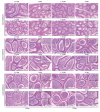Comparison of male reproductive parameters in mice with type 1 and type 2 diabetes
- PMID: 32036645
- PMCID: PMC7127904
- DOI: 10.5653/cerm.2020.00388
Comparison of male reproductive parameters in mice with type 1 and type 2 diabetes
Abstract
Objective: The differences between type 1 and type 2 diabetes mellitus (T1DM and T2DM) in terms of their adverse effects on male reproductive parameters have never been elucidated. This study aimed to distinguish between the effects of the DM types in mice treated with multiple low doses of streptozotocin (STZ) to mimic human T1DM and coadministered a high-fat diet (HFD) to mimic human T2DM.
Methods: The T1DM mice were intraperitoneally injected with STZ (40 mg/kg body weight) for 5 days. The T2DM mice received an HFD for 14 days prior to STZ injection (85 mg/kg body weight), followed by continuous feeding of an HFD. Male reproductive parameters were evaluated.
Results: The reproductive organs of the DM mice weighed significantly less than those of controls, and the seminal vesicles plus prostates of the T1DM mice weighed less than those of the T2DM mice. Increased sperm abnormalities and incomplete DNA packaging were observed in the DM groups. Sperm concentration and the proportion of normal sperm were significantly lower in the T1DM group. The seminiferous histopathology of DM mice was classified into seven types. The penises of the DM mice were smaller than those of the controls; however, tunica albuginea thickness and the amount of penile collagen fibers were increased in these mice. Round germ cells were abundant in the epididymal lumens of the mice with DM.
Conclusion: T1DM adversely affected reproductive parameters to a greater extent than T2DM.
Keywords: Mice; Sperm; Streptozotocin; Type 1 diabetes mellitus; Type 2 diabetes mellitus.
Conflict of interest statement
No potential conflict of interest relevant to this article was reported.
Figures











Similar articles
-
Alterations of morphology and phosphorylated protein expression in the seminal vesicles of diabetic mice.Andrologia. 2019 Nov;51(10):e13406. doi: 10.1111/and.13406. Epub 2019 Sep 9. Andrologia. 2019. PMID: 31502269
-
Testicular histopathology and phosphorylated protein changes in mice with diabetes induced by multiple-low doses of streptozotocin: An experimental study.Int J Reprod Biomed. 2018 Apr;16(4):235-246. Int J Reprod Biomed. 2018. PMID: 29942931 Free PMC article.
-
Expression of testicular phosphorylated proteins in types 1 and 2 diabetes mellitus in mice: An experimental study.Int J Reprod Biomed. 2019 Sep 3;17(8):567-576. doi: 10.18502/ijrm.v17i8.4822. eCollection 2019 Aug. Int J Reprod Biomed. 2019. PMID: 31583374 Free PMC article.
-
Gray Matter Abnormalities in Type 1 and Type 2 Diabetes: A Dual Disorder ALE Quantification.Front Neurosci. 2021 Jun 7;15:638861. doi: 10.3389/fnins.2021.638861. eCollection 2021. Front Neurosci. 2021. PMID: 34163319 Free PMC article.
-
Diabetes Mellitus Type 1 has a Higher Impact on Corneal Endothelial Cell Density and Pachymetry than Diabetes Mellitus Type 2, Independent of Age: A Meta-Regression Model.Cornea. 2022 Aug 1;41(8):965-973. doi: 10.1097/ICO.0000000000002841. Epub 2021 Sep 22. Cornea. 2022. PMID: 34561313 Free PMC article.
Cited by
-
First-line Evaluation of Sperm Parameters in Mice ( Mus musculus ).Bio Protoc. 2022 Oct 20;12(20):e4529. doi: 10.21769/BioProtoc.4529. eCollection 2022 Oct 20. Bio Protoc. 2022. PMID: 36353714 Free PMC article.
-
Gut-Testis Axis: Microbiota Prime Metabolome To Increase Sperm Quality in Young Type 2 Diabetes.Microbiol Spectr. 2022 Oct 26;10(5):e0142322. doi: 10.1128/spectrum.01423-22. Epub 2022 Oct 10. Microbiol Spectr. 2022. PMID: 36214691 Free PMC article.
-
Tribulus terrestris Efficacy and Safety Concerns in Diabetes and Erectile Dysfunction, Assessed in an Experimental Model.Plants (Basel). 2021 Apr 10;10(4):744. doi: 10.3390/plants10040744. Plants (Basel). 2021. PMID: 33920217 Free PMC article.
-
The Effect of Palm Pollen and Black Seed Pollen on Male Sex Hormones and Sperm Quality: A Single-Blind, Placebo-Controlled Clinical Trial Study.Int J Fertil Steril. 2023 Jan 1;17(1):75-79. doi: 10.22074/ijfs.2022.548477.1259. Int J Fertil Steril. 2023. PMID: 36617207 Free PMC article. Clinical Trial.
-
Garden Cress Seed Oil Abrogates Testicular Oxidative Injury and NF-kB-Mediated Inflammation in Diabetic Mice.Int J Mol Sci. 2023 Oct 23;24(20):15478. doi: 10.3390/ijms242015478. Int J Mol Sci. 2023. PMID: 37895159 Free PMC article.
References
-
- Report of the Expert Committee on the Diagnosis and Classification of Diabetes Mellitus. Diabetes Care. 1997;20:1183–97. - PubMed
-
- Frier BM, Fisher M. Diabetes mellitus. In: Colledge NR, Walker BR, Ralston S, Davidson S, editors. Davidson’s principles and practice of medicine. India: Elsevier; 2010. p. 735.
-
- Ahangarpour A, Oroojan AA, Heidari H, Ghaedi E, Taherkhani R. Effects of hydro-alcoholic extract from Arctium lappa L. (Burdock) root on gonadotropins, testosterone, and sperm count and viability in male mice with nicotinamide/streptozotocin-induced type 2 diabetes. Malays J Med Sci. 2015;22:25–32. - PMC - PubMed
LinkOut - more resources
Full Text Sources

